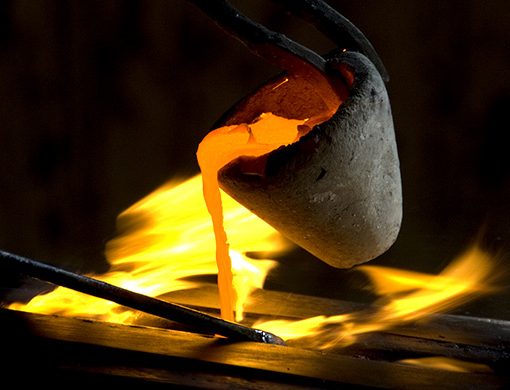Master alloys help copper shine
Red metals have played an important role in many cultures, including those of the ancient Egyptians and Romans, who crafted tools, cookware, dishes, mirrors and razors out of copper. Modern uses for copper include electrical, heating/cooling applications, fluid handling and plumbing applications, as well as an increasing demand for the material in architectural and building products, such as gutters, fascias, flashing, roofs and dormers.
Copper is a soft, malleable, corrosion-resistant and ductile material with high thermal and electrical conductivity. It can be combined easily with other metals—in fact, the first alloy produced combined copper with tin to form bronze. Copper often is alloyed with base metals, such as zinc, silicon, tin, nickel, chromium and beryllium, to produce brasses and bronzes that are used to make a variety of artistic, jewelry, marine and industrial products.
Master alloys can be added to a melt to increase the fluidity, hardness, color and ductility of copper alloys. Master alloys are base metals combined with a high percentage of one or two other elements and are used as additives in the manufacture of other alloys. Those that contribute to increased strength are referred to as hardeners. Others are called grain refiners and provide control over the alloy’s structure. Master alloys also can be used as deoxidizers, degasifiers and desulphurizing agents.
Copper master alloys can include beryllium, boron, cadmium, chromium, iron, lithium, magnesium, manganese, nickel, phosphorous, silicon, tellurium, titanium, zinc and zirconium. Each of these elements has characteristics that can strengthen copper’s inherent properties, making the resulting alloy more suitable for specialized applications.
Zirconium, for example, has a high melting point, and is easier to control when combined into a copper zirconium master alloy. A copper zirconium master alloy with a lower percentage of zirconium may be preferred when producing precipitation hardening alloys for improved high temperature properties, while a higher percentage zirconium can be used for grain refining to improve mechanical properties, reduce porosity and increase fluidity.
Beryllium copper is a copper alloy that has 0.5 to 3 percent beryllium. It combines high strength with nonmagnetic and non-sparking qualities. Often, it’s used when it’s important to have a material that is easily formed, has high fatigue strength, good hysteresis properties and creep resistance. Beryllium copper also is used for alloys that need to be strong, resistant to corrosion, and relatively high conductors of electricity.
Boron copper and lithium copper are good choices for deoxidizing and degasifying pure copper and cupronickel alloys. These master alloys are especially useful for pure copper castings since they do not reduce conductivity. When the proper melting and deoxidation procedures are used, it is possible to produce copper castings with higher than 90 percent conductivity.
Experienced metallurgists work to formulate copper master alloys so they provide reliable results in foundries, brass mills, ingot producers, centrifugal casters, precious metal alloyers, refiners and other metallurgical operations. It’s important to collaborate with these experts when working with molten metal to ensure correct master alloys are chosen and end products meet specifications.

